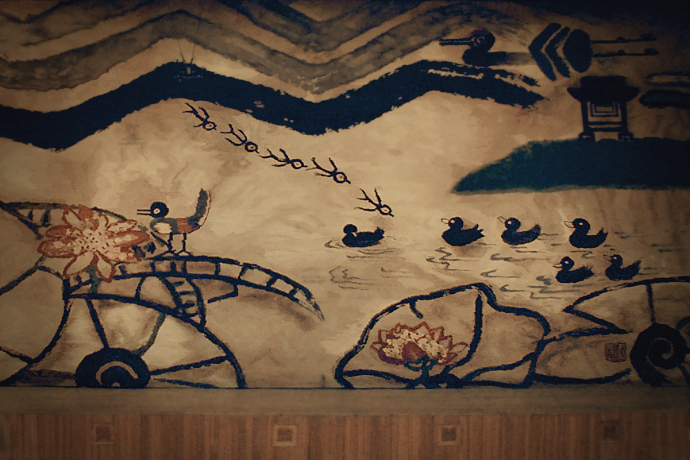
I was invited by my new friend to attend her end-of-course presentation at the National Center for Korean Traditional Performing Arts (국립국악원, 國立國樂院) last Saturday morning. The performance was meant to be some sort of a report card for foreigners who signed up last Fall to learn to play Korean traditional instrument like Janggu, Gayageum and Danso.
The National Center for Korean Traditional Performing Arts
The NCKTPA's main mission is to ensure the continuity of the Korean traditional music through promotion and sharing of the music with the people of Korea and the world.
To get to NCKTPA, I took metro line 3 to Nambu Bus Terminal (남부터미널) station, exit from Exit 5 and got onto bus 4429. NCKTPA is just beside the Seoul Arts Center (예술의 전당, 藝術的殿堂) and directly opposite of Arirang Broadcasting Station.
The performance staged at the Umyeon-dang (우면당) commenced at 10:30am.
 |
| The stage curtain of Umyeon-dang is a like one big painting |
Janggu (Hourglass-shaped Drum)
The opening performance was by the Janggu (장구, 杖鼓) class. I believe there is a very good reason to start off with Janggu. The fast thumping sound of drum really woke up my otherwise sleepy mind.



Gayageum (Beginner's) - 12 Stringed Zither
The Gayageum (가야금, 伽倻琴) as its name suggests, is invented in Gaya, a confederacy which was later annexed by Shilla during the period of Three Kingdom. If Janggu is considered the "yang" instrument than Gayageum is the "ying" instrument. The sound produced by the instrument is softer and more melodious. Hearing Janggu and Gayageum back to back gave an indescribable sense of harmony.


Dodeuri
Next on stage was a group of professional musicians. Below is how the event booklet describes their music:
"Dodeuri" is a style of chamber ensemble music enjoyed by the intellectuals during the late Joseon period. "Dodeuri" literally means "to return" and is based on the variation of melodies from "Boheoja", which is the court music from the Goryeo period. Its high-spirited air and cheerful mood, arising from its straightforward rhythm and moderate tempo, well represent the high spirits of scholars during Joseon period.
"Dodeuri" is almost like music inspired by nature. I thought I "heard" the sound of wind blowing, water dripping and leaves rustling while the music was played.


Danso - Vertical Bamboo Flute
The Danso (단소, 短簫) class started their piece slightly out of sync and they continued for quite a while before the guy (not wearing traditional costume) called for a restart. After that, everything went on smoothly. I thought I should be able to play Danso much better than other instrument because it looks simple enough. It looks like the Recorder I used to play during school's music lesson.


Gayageum (Intermediate)


Janggitaryeong
This is how the event booklet describes Janggitaryeong:
Janggitaryeong is one of Gyeongi province folksongs and was named so because the song describes about chinese chess at the end of it.
I did not know what the songstresses were singing. All I could say is that they look pretty like 3 petals of a flower resting on the stage. A very pleasant sight from the audience's perspective.


Samulnori - Percussion Quartet
Samulnori was the 마지막 하이라이트 (finale) of the day and they gave the best performance of the day that befits a finale. Instead of saying that they were giving a performance, I would rather say that they were enjoying what they were playing.




Group Photo



After watching the performance, I started to miss my play-acting days. If given a chance, I will like act in a Korean play. I think memorising script is a very effective way of learning a language. Anyway, perhaps I should consider joining the Danso class next year though I like Samulnori more. There is a few more months for me to decide. Shall think about it again when the date get closer.
For those who are interested and are living in Seoul, class is opened to all foreigners twice a year in Spring and Fall. The Spring semester 2009 Korean traditional music class is scheduled from Mar 7 ~ May 30. Class is every Saturday from 10:30 to 12:30. Courses that will be opened include Janggu, Gayageum, Sanso and Samulnori. For more information, you can visit their website (http://www.ncktpa.go.kr/) or you can contact their manager at: eric@ncktpa.go.kr, 02-580-3054.
P.S. To my new friend: 장구를 치는 모습이 너무 멋져요! ^^

No comments:
Post a Comment